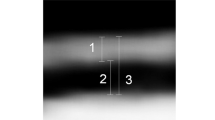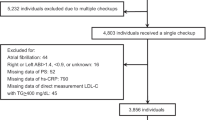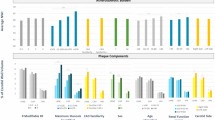Abstract
Both carotid intima–media thickness (cIMT) and carotid plaque (CP) quantified by B-mode ultrasound have been proposed as surrogate imaging biomarkers of subclinical atherosclerosis, while the relationship between cIMT and CP, whether cIMT evaluation in a given patient might allow for predicting the development of a carotid plaque, is still discussed controversially. We investigated the cross-sectional relationship between cIMT and CP, and the predictive value of cIMT for incident CP formation in 1078 subjects with mean age of 52 ± 5 years in a community based atherosclerosis cohort in Beijing. Participants underwent ultrasonography of bilateral carotid arteries and received vascular risk factor assessment at baseline and after a mean of 2.35 years follow-up. The prevalence of plaque was increased by 3.75-fold for upper quartile cIMT compare with the lower quartile even after adjustments for traditional risk factors at baseline. Among the 746 plaque-free subjects at baseline, 230 (31.0%) developed new CP. After adjusted for demographics and vascular risk factors, neither baseline cIMT nor the cIMT change from baseline to follow-up predicted incident CP. In conclusion, although cIMT associates with CP cross-sectionally, increased cIMT dose not independently predict future plaque development. Our data suggest that paying attention to the traditional risk factors might prevent subjects from developing carotid plaques regardless from IMT changes.
This is a preview of subscription content, access via your institution
Access options
Subscribe to this journal
Receive 12 digital issues and online access to articles
$119.00 per year
only $9.92 per issue
Buy this article
- Purchase on Springer Link
- Instant access to full article PDF
Prices may be subject to local taxes which are calculated during checkout
Similar content being viewed by others
References
Touboul PJ, Hennerici MG, Meairs S, Adams H, Amarenco P, Bornstein N, et al. Mannheim carotid intima–media thickness and plaque consensus (2004–2006–2011). An update on behalf of the advisory board of the 3rd, 4th and 5th watching the risk symposia, at the 13th, 15th and 20th European Stroke Conferences, Mannheim, Germany, 2004, Brussels, Belgium, 2006, and Hamburg, Germany, 2011. Cerebrovasc Dis. 2012;34:290–6.
Pignoli P, Tremoli E, Poli A, Oreste P, Paoletti R. Intimal plus medial thickness of the arterial wall: a direct measurement with ultrasound imaging. Circulation. 1986;74:1399–406.
Spence JD. Ultrasound measurement of carotid plaque as a surrogate outcome for coronary artery disease. Am J Cardiol. 2002;89:10–15.
Zureik M, Ducimetière P, Touboul PJ, Courbon D, Bonithonkopp C, Berr C, et al. Common carotid intima–media thickness predicts occurrence of carotid atherosclerotic plaques: longitudinal results from the Aging Vascular Study (EVA) study. Arterioscler Thromb Vasc Biol. 2000;20:1622–9.
von Sarnowski B, Lüdemann J, Völzke H, Dörr M, Kessler C, Schminke U, et al. Common carotid artery intima–media thickness and Framingham risk score predict incident carotid atherosclerosis plaque formation: longitudinal results from the SHIP study (Study of Health In Pomerania). Stroke. 2010;41:2375–7.
Rundek T, Gardener H, Della-Morte D, Dong C, Cabral D, Tiozzo E, et al. The relationship between carotid intima–media thickness and carotid plaque in the Northern Manhattan Study. Atherosclerosis. 2015;241:364–70.
Ebrahim S, Papacosta O, Whincup P, Wannamethee G, Walker M, Nicolaides AN, et al. Carotid plaque, intima media thickness, cardiovascular risk factors, and prevalent cardiovascular disease in men and women: the British Regional Heart Study. Stroke. 1999;30:841–50.
Fan F, Qi L, Jia J, Xu X, Liu Y, Yang Y, et al. Noninvasive central systolic blood pressure is more strongly related to kidney function decline than peripheral systolic blood pressure in a Chinese community-based population. Hypertension. 2016;67:1166–72.
Cheng G, Fan F, Zhang Y, Qi L, Jia J, Liu Y, et al. Different associations between blood pressure indices and carotid artery damages in a community-based population of china. J Hum Hypertens. 2016;30:750–4.
Al-Shali KZ, House AA, Hanley AJ, Khan HM, Harris SB, Zinman B, et al. Genetic variation in PPARG encoding peroxisome proliferator-activated receptor gamma associated with carotid atherosclerosis. Stroke. 2004;35:2036–40.
Finn AV, Kolodgie FD, Virmani R. Correlation between carotid intimal/medial thickness and atherosclerosis: a point of view from pathology. Arterioscler Thromb Vasc Biol. 2010;30:177–81.
Ferreira JP, Girerd N, Bozec E, Machu JL, Boivin JM, London GM, et al. Intima–Media thickness is linearly and continuously associated with systolic blood pressure in a population-based cohort (STANISLAS Cohort Study). J Am Heart Assoc. 2016;5:e003529.
Moskau S, Golla A, Grothe C, Boes M, Pohl C, Klockgether T, et al. Heritability of carotid artery atherosclerotic lesions: an ultrasound study in 154 families. Stroke. 2005;36:5–8.
Bonithonkopp C, Touboul PJ, Berr C, Leroux C, Mainard F, Courbon D, et al. Relation of intima–media thickness to atherosclerotic plaques in carotid arteries. The Vascular Aging (EVA) Study. Arterioscler Thromb Vasc Biol. 1996;16:310–6.
Persson J, Formgren J, Israelsson B, Berglund G. Ultrasound-determined intima–media thickness and atherosclerosis. Direct indirect Valid Arterioscler Thromb. 1994;14:261–4.
Li R, Duncan BB, Metcalf PA, Sharrett AR, Tyroler HA, Barnes R, et al. B-mode-detected carotid artery plaque in a general population. Atherosclerosis Risk in Communities (ARIC) Study Investigators. Stroke. 1994;25:2377–83.
Rosfors S, Hallerstam S, Jensenurstad K, Zetterling M, Carlström C. Relationship between intima–media thickness in the common carotid artery and atherosclerosis in the carotid bifurcation. Stroke. 1998;29:1378–82.
Prati P, Vanuzzo D, Casaroli M, Bader G, Mos L, Pilotto L, et al. Determinants of carotid plaque occurrence. A long-term prospective population study: the San Daniele Project. Cerebrovasc Dis. 2006;22:416–22.
Eigenbrodt ML, Bursac Z, Tracy RE, Mehta JL, Rose KM, Couper DJ, et al. B-mode ultrasound common carotid artery intima–media thickness and external diameter: cross-sectional and longitudinal associations with carotid atherosclerosis in a large population sample. Cardiovasc Ultrasound. 2008;6:10–10.
Johnsen SH, Fosse E, Joakimsen O, Mathiesen EB, Stensland-Bugge E, Njølstad I, et al. Monocyte count is a predictor of novel plaque formation: a 7-year follow-up study of 2610 persons without carotid plaque at baseline the Tromso Study. Stroke. 2005;36:715–9.
Roman MJ, Naqvi TZ, Gardin JM, Gerhard-Herman M, Jaff M, Mohler E, et al. Clinical Application of Noninvasive Vascular Ultrasound in Cardiovascular Risk Stratification: A Report from the American Society of Echocardiography and the Society of Vascular Medicine and Biology. Vasc Med. 2006;19:943–54.
Acknowledgements
This study was supported by grants from the University of Michigan–Peking University Health Science Centre (UM-PUHSC) Joint Institute for Translational and Clinical Research (grant no: BMU20110177 and BMU20160530). This study was also supported by Beijing Lisheng Cardiovascular Health Foundation and Projects of National Natural Science Foundation of China (grant 81703288).
Author information
Authors and Affiliations
Corresponding authors
Ethics declarations
Conflict of interest
The authors declare that they have no conflict of interest.
Additional information
Publisher’s note Springer Nature remains neutral with regard to jurisdictional claims in published maps and institutional affiliations.
Rights and permissions
About this article
Cite this article
Yang, Y., Fan, F., Gao, L. et al. The relationship between carotid intima–media thickness and carotid plaque: a cohort study in China. J Hum Hypertens 34, 468–473 (2020). https://doi.org/10.1038/s41371-019-0252-5
Received:
Revised:
Accepted:
Published:
Issue Date:
DOI: https://doi.org/10.1038/s41371-019-0252-5



